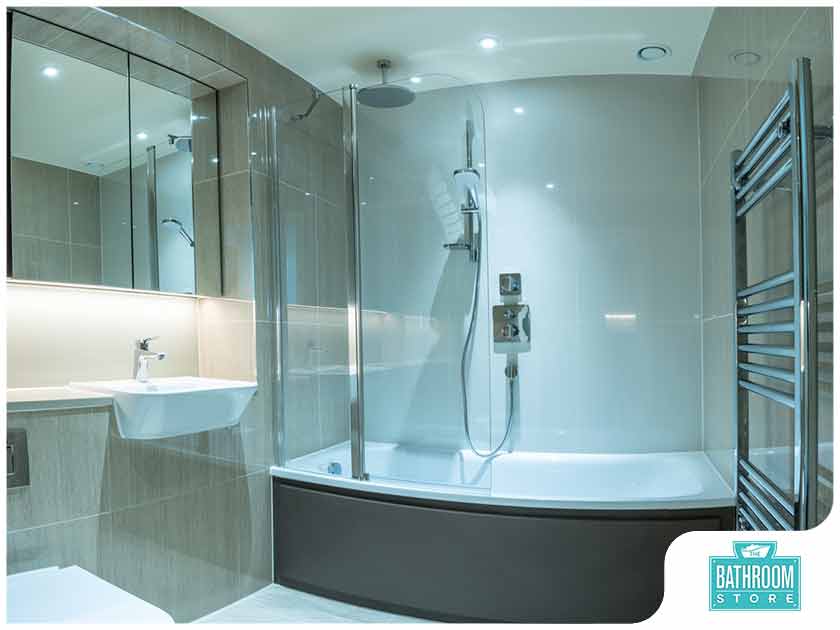A tub-to-shower conversion can yield many benefits. For example, if you have elderly family members in your household, a shower may be easier for them to access than a bathtub with a ledge. Aesthetically, a shower can offer a fresh and modern appearance compared to an old fashioned tub. Recent home improvement surveys reveal a growing popularity of walk-in showers among homeowners.

Whether you’re undertaking this renovation out of necessity or for aesthetic reasons, it will pay off in terms of comfort, ease of use, style and enjoyment. It also makes your home more desirable to potential buyers, if you are looking to sell in the future. As with other home remodeling projects, converting your bathtub into a shower requires a great deal of planning. It is a financial commitment, after all, so start by putting everything down on paper.
Before you remove tiles, look into the best grout color and take home the items you need to install. You’ll need to take precise measurements and do plenty of planning and research. Here are some important planning tips to ensure a successful tub-to-shower conversion.
Don’t Get Rid of Your Only Tub
Does your home only have one bathtub? Unless you have at least two bathrooms with a tub in each one, you might want to think twice about converting your lone tub into a shower, especially if you intend to sell your home in a few years.
According to real estate professionals, a home without a bathtub has a lesser chance of getting sold. A tub is considered an amenity, and in real estate, homes with the most amenities are highly appealing to buyers. Also, the need for at least one tub is most common among two specific homeowner groups: young families with small children and luxury homeowners who lived in houses with multiple bathrooms.
Waterproof the Window
There might be a window right above the bathtub. If you intend to push through with the project, be sure to take this into consideration. The window might be in the direct line of sight of your neighbors, so consider investing in textured glass or window treatments if privacy is a concern. Also, a shower built near a window offers too many opportunities for water to infiltrate through your walls and window casing, which can lead to the growth of mold and mildew.
If you want to keep the window where it is, make sure your choice of wall material, whether it is tile or marble, is also installed into the window reveal. From there, the window can be sealed before fitting a waterproof shutter. This will allow natural light to pass through the window and illuminate your bathroom.
Take Accurate Measurements
One of the most important things about planning this bathroom remodel is making sure you have the space for the shower you want. Consult the local building codes for guidance. Most bathtubs measure 60 inches in width, which is just enough to fit your shower, but be sure you take measurements just to confirm. As for the depth, there should be at least 32 to 34 inches from the finished tile wall to the potential glass shower door.
Also, the finished ceiling height must be at least 80 inches (six feet, eight inches). To comply with the bathroom guidelines of the National Kitchen & Bath Association (NKBA), the shower floor must have dimensions of at least 30 by 30 inches (36 by 36 inches is recommended). The minimum distance from the shower wall to the toilet should be 15 inches from center and 21 inches from the front of the toilet bowl (18 and 30 inches are recommended, respectively). Take these measurements into account to ensure the new shower doesn’t feel cramped.
Take Note of Plumbing Issues
Installing a walk-in shower to replace your old bathtub is a great way to bring luxury and elegance to a small bathroom area. However, you may decide that you don’t have enough space or you want to go for a little larger shower area. In either case, this would entail relocating the shower’s plumbing, which can create problems if not mapped out properly during the planning phase of the remodel.
Various situations can make plumbing repositioning tricky. For instance, it may be more difficult to move pipes inside the bathroom on your home’s upper levels. Relocating pipes may require cutting through concrete if you have a slab foundation. Accessing the downpipe, which carries wastewater to the sewers, may involve removing a section of the bathroom wall. Unless you have enough funds to cover for this aspect of the project, you might be better off having the shower installed within the footprint of the bathtub. If you’re able to work with the space you have, expect to save on costs and effort.
Choose the Right Shower for Your Space
Now that you’ve measured and planned, it’s time you design your shower. Consider which fixtures would be the best fit for the space. Research showerhead and faucet options, as well as their accompanying finishes. For the benefit of individuals in your household with physical limitations, you may want to add grab bars and a bench.
Consider your lighting and tile layout, which are keys to giving your shower a polished look. Start with installing lights in and around the shower before proceeding with the tiles. In planning the tile layouts, use the ceiling height as a reference. Tiling first without any light source in place makes it hard to determine the amount of lippage that tiles have.
Then, decide which shower type to install in your bathroom space that’s previously been occupied by the tub. Take note of these choices:
- Shower Stall – If you want a less costly option, an all-in-one shower stall might work well. Numerous options come with built-in ledges and shelving, with some even having seating areas. Shower stalls usually have a curb to corral water and your shower door of choice, whether it is framed, frameless or semi-frameless. You can even settle for a curtain if you wish.
- Tiled Shower – This type of shower has a ledge to hold the door and keep the water inside the shower. It should be short enough to step over with ease and tall enough to prevent water from spilling into the rest of the bathroom. It should also have smooth edges to limit injuries.
- Curbless Shower – This type of shower is much easier to access for the elderly and people with mobility issues. It offers a more modern appeal and is a good option if you want to make the most of a smaller bathroom area. On the downside, water can’t be contained as well as with a curbed shower, though this can be solved with a pivoting glass door.
Work With Bathroom Remodeling Pros
When planning a tub-to-shower conversion, you need professionals to guide you in the right direction. Not all contractors can deliver the same quality of work, so be sure to choose one that can provide the service you need and do it well. At The Bathroom Store, our team will work closely with you to identify your wants and needs for your bathroom remodeling project.
Our company specializes in bathroom renovations, including tub and shower installation projects. We also offer a vast selection of vanities, sinks, faucets and other accessories and finishes to complete your bathroom’s look and feel.
Let us take out your outdated tub and design a luxurious shower space within it with all the comforts you and your family need. Give us a call at (701) 223-1008 or fill out our contact form to schedule a consultation.



